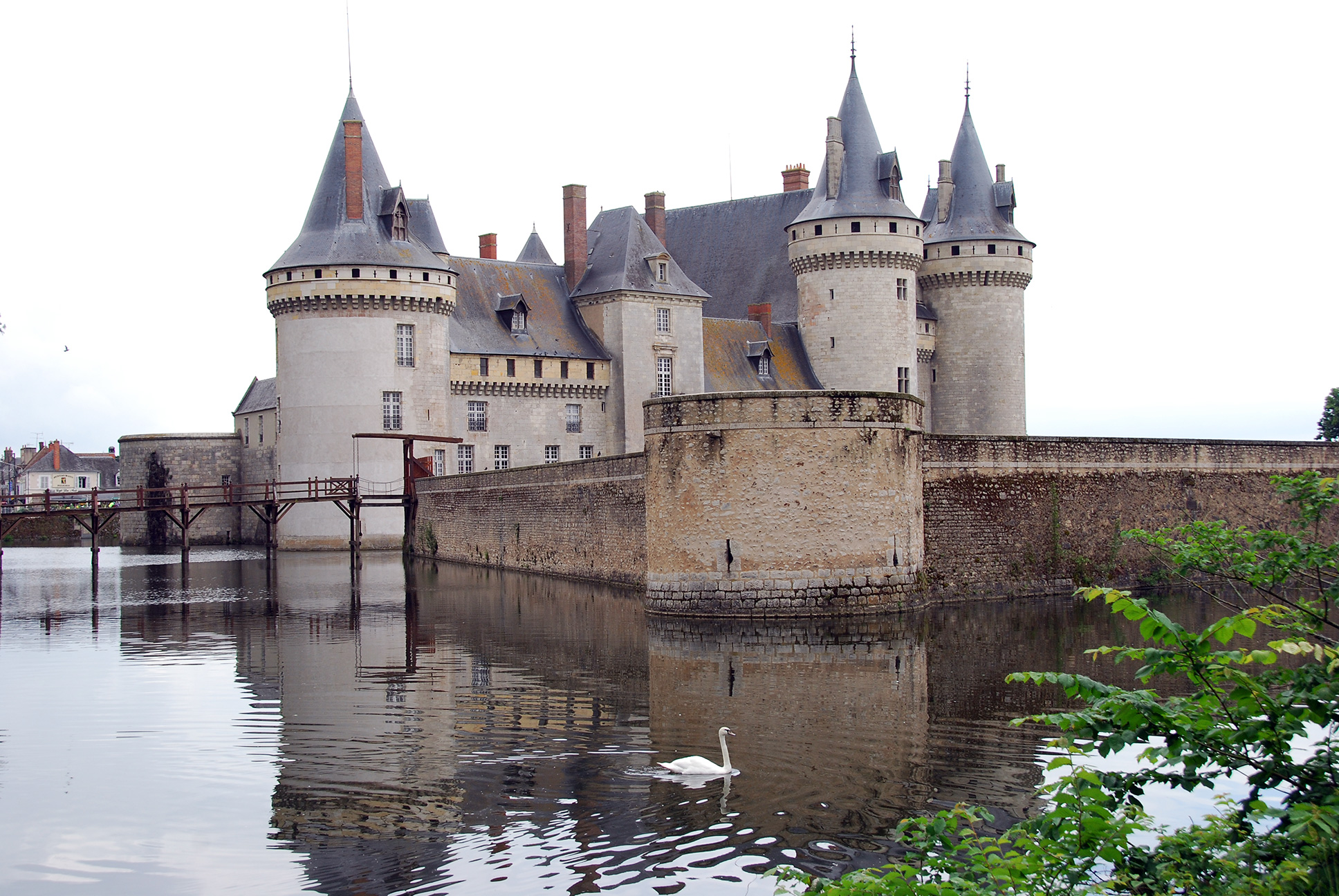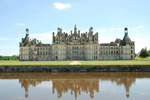History
Château de Sully-sur-Loire is strategically positioned at the confluence of the Rivers Loire and Sange, just east of Orléans, France. The oldest parts of the castle we see today are from 1395, when Guy de la Trémoïlle began constructing the keep, flanked by four round towers as well as a south-facing entrance with a drawbridge flanked by two towers, giving the castle an L-shaped plan.

When Guy was killed during the crusade of Nicopolis in 1396, his wife Marie completed the construction of the keep, apart from the two western towers, which were never finished. In 1401, she began refurbishing a house within the castle complex, now known as the Petit Château, between the Gate Tower and the River Sange.
Guy's son, George de la Trémoïlle, was a chamberlain and a favorite of Charles VII. He entertained the King and Joan of Arc at Sully in June of 1429, two months after the Siege of Orléans, as they campaigned to recapture bridge points in Meung and Beagency on the River Loire. Joan would return to Sully in March of 1430. By this time, she was closely watched as she had broken the truce between Charles and the Burgundians by attacking Paris. She was held at the castle by George but escaped. She was captured on her way to Compiègne on May 23rd, 1430, and would be charged with heresy and burned at the stake in Rouen on May 30th, 1431.
In 1602, the castle was purchased by Maximilien de Béthune, Marquis of Rosny and the first minister and good friend of King Henry IV. He was known as "Grand Sully" and was appointed Duke of Sully and Peer of France in 1606. In 1606, he ordered the construction of the artillery tower, which he called the Béthune Tower, to strengthen the side of the castle facing the town. He also added passageways connecting the new tower to the keep and the Petit Château, which changed the castle layout from an L-shaped plan to a fully enclosed castle with an inner courtyard. The dry moat around the castle was then filled with water by diverting water from the River Sange, which flows next to the castle.
In March of 1652, the young King Louis XIV came to the caste during the Revolt against royal authority and stayed in the castle for two nights, sleeping in the King's Room on the first floor of the keep.
Voltaire sheltered at Sully-sur-Loire in 1716 and 1719 after he had been exiled from Paris for affronting the Regent, Philippe II, Duke of Orléans. He described the castle in a letter as "the most likeable of castles and in the best company in the world."
In 1767, the gallery that connected the Petit Château to the keep was enlarged by constructing an additional floor. Later that century, during the French Revolution in 1794, the 8th Duke of Sully was obliged to slight the castle defenses by communal decree. He had the crowns (conical roofs) of all six keep towers removed, and the western gallery wall was destroyed, exposing the inner courtyard. As was common during the Revolution, the tombs of the Lords were opened, and the bodies were reinterred in anonymous graves. Maximilien I and his wife's bodies were moved in 1793.
At the start of the 19th century, the 8th Duke of Sully and his son died, leaving no heir. The Château de Sully-sur-Loire became the property of the Béthune-Sully family, cousins to the Duke. In 1900, they set out to have the six tower roofs restored, but by 1904, only two of the towers were restored as the castle chatelaine died of poisoning after the chef accidentally mixed up a pot of flour and a pot of arsenic when preparing a meal. This ended the roof reconstruction project. In 1918, a fire started in the wing built in the 18th century, destroying several rooms. It was rebuilt in 1920, with a floor and half removed, leaving the space as a large empty shell.
In 1940 and again in 1944, Château de Sully-sur-Loire was damaged by shell fire during intense fighting between the banks of the River Loire. It was used as the German General Staff Headquarters during World War II when much of the furniture was removed. The castle was sold to the Loiret Local Council in 1962, which restored much of the castle and opened it to the public.
Castle Highlights
Unlike most other castles on the Loire built during the Renaissance, Sully Sur Loire is much older and an authentic medieval fortress. Made using white limestone with slate conical roofs and machicolations along the walls and towers, the castle and its setting on a moat give it a picturesque fairytale feel. Before entering the castle, take the time to walk entirely around the castle to see it from all angles and from across the moat.
The most impressive feature of the castle architecturally is the rectangular keep or donjon and its flanking towers, which has three floors, including the garret at the roof level.
The castle's interior can be visited either on a guided tour or a self-guided tour with information booklets to tell you about each room. Some rooms are furnished and decorated in different styles.
The State Bedroom or "King's Bedroom" retains paneling from the 1660s as well as tapestries, paintings, and Louis XIII period furniture as well as the Roi Soleil (bed, lamps, and blue armchairs in the Louis XIV style).
The Salle d'Honneur, or Hall of Honour, has a 15th century chimney with a painting of Rosny Castle above the mantle. This room was used as a theater on occasion, perhaps for some of Voltaire's performances during his stays.
Sully also has a covered Chemin de Ronde or wall walk where you can see through the machicolations and from which heavy objects would be dropped down on attacking enemies outside the castle.
Château de Sully-sur-Loire can be explored in two to three hours. To see more castles the same day, the Château de Chamerolles is about a 45-minute drive to the north. The Château de Chambord is 90 Minutes to the west but takes almost a full day to explore.



